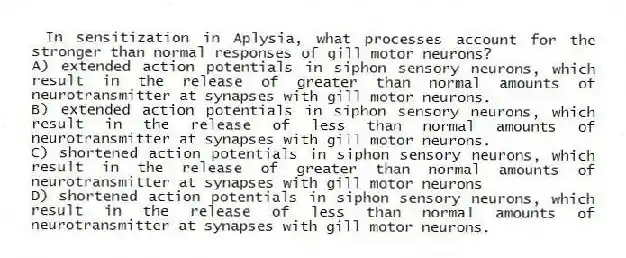
In sensitization in Aplysia, what processes account for the stronger than normal responses of gill motor neurons?
A) extended action potentials in siphon sensory neurons, which result in the release of greater than normal amounts of neurotransmitter at synapses with gill motor neurons.
B) extended action potentials in siphon sensory neurons, which result in the release of less than normal amounts of neurotransmitter at synapses with gill motor neurons.
C) shortened action potentials in siphon sensory neurons, which result in the release of greater than normal amounts of neurotransmitter at synapses with gill motor neurons
D) shortened action potentials in siphon sensory neurons, which result in the release of less than normal amounts of neurotransmitter at synapses with gill motor neurons.
Correct Answer:
Verified
Q54: Just before class, Willis asked you the
Q55: In sensitization experiments, shocking the head or
Q56: Patients with anterograde amnesia show deficits in
A)
Q57: Before reading the chapter on neuropsychology in
Q58: A good example of a semantic memory
Q60: Habituation in Aplysia can last up to
A)
Q61: Which of the following proteins play a
Q62: "Associativity" in the Hebbian synapse refers to
Q63: In studies of classical conditioning in Aplysia,
Q64: Classical conditioning in Aplysia results primarily from
A)
Unlock this Answer For Free Now!
View this answer and more for free by performing one of the following actions

Scan the QR code to install the App and get 2 free unlocks

Unlock quizzes for free by uploading documents